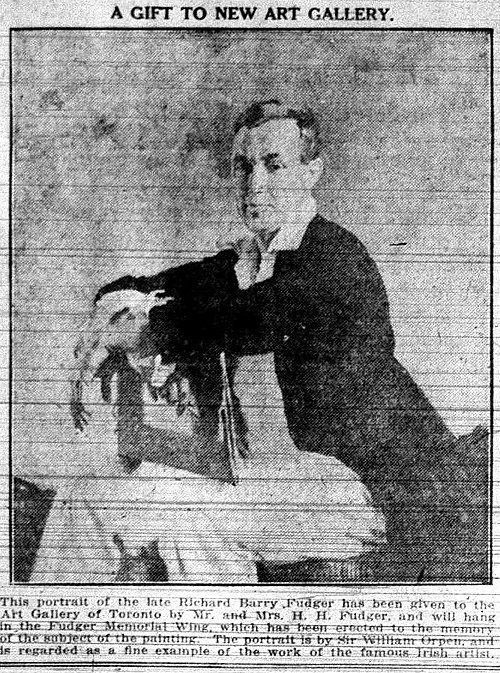bonus features: the modest millionaire
Before reading this post, check out the related article on Torontoist.

Source: Mail and Empire, January 16, 1926.
One mystery I didn't resolve was the exact nature of Dick Fudger's chronic illness. At first, given that he had spent winters in California, tuberculosis or another respiratory ailment crossed my mind, as the trend during the period was to send those with such diseases to the southwest in the hope that the drier climate would alleviate their misery. As I read more, it appeared health was only one of the reasons he often headed to the West Coast—business matters and family were others, since he had married in California.
Whatever malady plagued Dick Fudger for most of his life, it was played a role in curtailing his studies at Oxford and prevented him from taking on more than a ceremonial role during World War I. Perhaps it was kidney or liver disease, or a bad heart? Was the exact affliction not mentioned in any source, even fifty years later, out of courtesy, common knowledge, or to hide something shameful? I'm ruling out the latter, since no accounts after his death hint at anything scandalous.
As for the Richard Barry Fudger Memorial Gallery and Rotunda at the Art Gallery of Toronto, its grand opening ceremonies were held on January 29, 1926. Guests were treated to a musical program courtesy of the Mendelssohn Choir and the dedication of the Sir Edmund Walker Memorial Court. Among the works exhibited were several old master paintings (including two Rembrandts) on loan from British art dealer Sir Joseph Duveen. In their review of the opening, the Mail and Empire expressed their awe at the magnificence of these works and took potshots at contemporary artists:
It also appears that the gallery developed an interesting strategy towards Canadian art: only the works of dead artists would be displayed.
***

Genevieve Clark, Bain News Service publisher, date unknown. Library of Congress LC-B2- 2680-3, derived from Flickr Commons.
The Sherbourne House Club had a special communication system set up to inform residents if a caller was looking for them via phone or in person, as the rooms lacked telephone hookups. In its centennial series of articles about the history of Simpson's, the Toronto Star included the system instructions from the resident's handbook and noted the problems that could arise:
***
Behind the scenes department: Coming up with ideas for Historicist posts is often an accident, based on a stray ad or story I find while researching something else. This post had its genesis while I was working on a piece about local press coverage of the death of Sir John A. Macdonald. While flipping through the Globe, I came across an ad for a wholesaler with an odd-sounding name: Fudger. Originally I figured I could dig up a little information and build a Vintage Toronto Ads column out of my discovery. A few Google searches and a scroll through the online archives of the Globe and Mail and the Star uncovered enough material to build a lengthy post around and prevented any attempts at lame jokes about fudge.
Additional material from the January 30, 1926 edition of the Mail and Empire and the January 7, 1972 edition of the Toronto Star. - JB

Source: Mail and Empire, January 16, 1926.
One mystery I didn't resolve was the exact nature of Dick Fudger's chronic illness. At first, given that he had spent winters in California, tuberculosis or another respiratory ailment crossed my mind, as the trend during the period was to send those with such diseases to the southwest in the hope that the drier climate would alleviate their misery. As I read more, it appeared health was only one of the reasons he often headed to the West Coast—business matters and family were others, since he had married in California.
Whatever malady plagued Dick Fudger for most of his life, it was played a role in curtailing his studies at Oxford and prevented him from taking on more than a ceremonial role during World War I. Perhaps it was kidney or liver disease, or a bad heart? Was the exact affliction not mentioned in any source, even fifty years later, out of courtesy, common knowledge, or to hide something shameful? I'm ruling out the latter, since no accounts after his death hint at anything scandalous.
As for the Richard Barry Fudger Memorial Gallery and Rotunda at the Art Gallery of Toronto, its grand opening ceremonies were held on January 29, 1926. Guests were treated to a musical program courtesy of the Mendelssohn Choir and the dedication of the Sir Edmund Walker Memorial Court. Among the works exhibited were several old master paintings (including two Rembrandts) on loan from British art dealer Sir Joseph Duveen. In their review of the opening, the Mail and Empire expressed their awe at the magnificence of these works and took potshots at contemporary artists:
Nothing like them has ever been seen locally. In fact, you will travel far to find eight such masterpieces from bygone days hanging together in one room. One feels again the patience and craftsmanship that used to be put into the arts, as opposed to the slap-dash methods of the present day. Just look at the gorgeous colours that have lasted through the centuries. They seem to have grown more mellow with the passage of time, richer and fuller, especially the blues and the various shades of red. The belt worn by the man in Rembrandt's "Standard Bearer" might be manufactured from the precious metal itself. Perhaps it may interest some people to know that in a picture like Bellini's "Madonna and Child", the painters used to pulverize stones in their paints to add to the richness. In the presence of "Daedalus and Icarus", than which there is no finer Van Dyke [sic] in existence, one feels that the old masters had things that the modern artists have lost, even though they may have developed new ideas and beauties.
It also appears that the gallery developed an interesting strategy towards Canadian art: only the works of dead artists would be displayed.
***

Genevieve Clark, Bain News Service publisher, date unknown. Library of Congress LC-B2- 2680-3, derived from Flickr Commons.
The Sherbourne House Club had a special communication system set up to inform residents if a caller was looking for them via phone or in person, as the rooms lacked telephone hookups. In its centennial series of articles about the history of Simpson's, the Toronto Star included the system instructions from the resident's handbook and noted the problems that could arise:
"There is a buzzer in each room. In single rooms, one buzz means a telephone call, two buzzes a caller. Where there are two in a roon, one buzz is for the girl whose surname comes first in the alphabet, two buzzes for the girl whose surname comes later in the alphabet."
The introductory pamphlet didn't attempt to settle the perplexing problem, if it arose, of how two girls with surnames beginning with the same letter would be informed one had a caller, the other a phone call.
***
Behind the scenes department: Coming up with ideas for Historicist posts is often an accident, based on a stray ad or story I find while researching something else. This post had its genesis while I was working on a piece about local press coverage of the death of Sir John A. Macdonald. While flipping through the Globe, I came across an ad for a wholesaler with an odd-sounding name: Fudger. Originally I figured I could dig up a little information and build a Vintage Toronto Ads column out of my discovery. A few Google searches and a scroll through the online archives of the Globe and Mail and the Star uncovered enough material to build a lengthy post around and prevented any attempts at lame jokes about fudge.
Additional material from the January 30, 1926 edition of the Mail and Empire and the January 7, 1972 edition of the Toronto Star. - JB
Comments